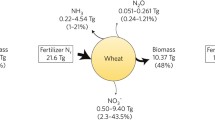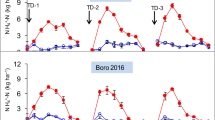Abstract
The role of ammonia volatilization as a nitrogen loss mechanism in lowland rice (Oryza sativa L.) has recently been extensively reevaluated using techniques that do not disturb the field environment. This paper summarizes methodologies used in this research and discusses findings from recently conducted micrometeorological studies on ammonia volatilization. Factors affecting ammonia loss and the contribution of this process to the overall nitrogen loss from lowland rice systems are also outlined. Suggestions for future research are included.
Similar content being viewed by others
References
Abbas R and Tanner RL (1981) Continuous determination of gaseous ammonia in the ambient atmosphere using fluorescence derivatization. Atmos Environ 15:277–281
Abichandani CT and Patnaik S (1955) Mineralizing action of lime on soil nitrogen in waterlogged rice soils. Int Rice Comm News Letter 13:11–13
Beauchamp EG, Kidd GE, and Thurtell G (1978) Ammonia volatilization from sewage sludge applied in the field. J Environ Qual 7:141–146
Beutier D and Renon H (1978) Representation of NH3-H2S-H2O, NH3-CO2-H2O, and NH3-SO2-H2O vapor-liquid equilibria. Ind Chem Process Des Dev 17:220–230
Bouldin DR and Alimagno BV (1976) volatilization losses from IRRI paddies following broadcast applications of fertilizer nitrogen. International Rice Research Institute. Internal Report. P.O. Box 933. Manila, Philippines (Unpublished mimeo)
Bouwmeester RJB and Vlek PLG (1981) Rate control of ammonia volatilization from rice paddies. Atmos. Environ. 15:131–140
Byrnes BH, Savant NK, and Craswell ET (1983) Effect of a urease inhibitor, phenyl phosphorodiamidate, on the efficiency of urea applied to rice. Soil Sci Soc Am J 47:270–274
Cao Zhi-Hong, De Datta SK, and Fillery IRP (1984) Effect of placement methods on floodwater properties and recovery of applied nitrogen (15N-labelled urea) in wetland rice. Soil Sci Soc Am J 48:196–203
Craswell ET, De Datta SK, Obcemea WN, and Hartantyo M (1981) Time and mode of nitrogen fertilizer application to tropical wetland rice. Fert Res 2:247–259
Craswell ET, De Datta SK, Weeraratne CS, and Vlek PLG (1985) Fate and efficiency of nitrogen fertilizers applied to wetland rice. I Philippines Fert Res 6:49–63
Craswell ET and Vlek PLG (1979) Greenhouse evaluation of nitrogen fertilizers for rice. Soil Sci Soc Am J 44:1884–1888
De Datta SK, Garcia FV, Abilay WP Jr., Alacantara JM, Mandac A, and Marciano VP (1979) Constraints to high rice yields, Nueva Ecija, Philippines. In Farm-level constraints to high rice yields in Asia: 1974–77, Int Rice Inst, Los Baños, Laguna, Philippines, pp. 191–234
De Datta SK and Zarata PM (1970) Environmental conditions affecting the growth characteristics, nitrogen response, and grain yield of tropical rice. Biometeorology 4:71–89
Denmead OT (1983) Micrometeorological methods for measuring gaseous losses of nitrogen in the field. In J R Freney and J R Simpson (Eds) Gaseous loss of nitrogen from plant-soil systems, Martinus Nijhoff/Dr W. Junk Publishers, The Hague, pp. 133–157
Denmead OT, Freney JR, and Simpson JR (1976) A closed ammonia cycle within a plant canopy. Soil Biol Biochem 8:161–164
Denmead OT, Freney JR, and Simpson JR (1982) Dynamics of ammonia volatilization during furrow irrigation of maize. Soil Sci Soc Am J 46:149–155
Denmead OT, Simpson JR, and Freney JR (1974) Ammonia flux into the atmosphere from a grazed pasture. Nature 185:609–610
Denmead OT, Simpson JR, and Freney JR (1977) The direct field measurement of ammonia emission after injection of anhydrous ammonia. Soil Sci Soc Am J 41:1001–1004
Fern M (1979) Method for determination of atmospheric ammonia. Atmos Environ 13:1385–1393
Fillery IRP and De Datta SK (1985) Effect of N source and a urease inhibitor on NH3 loss from flooded rice (1) Micrometeorological technique, ammonia fluxes and15N loss. Soil Sci Soc Am J (in press)
Fillery IRP, Roger PA, and De Datta SK (1985) Effect of N source and a urease inhibitor on NH3 loss from flooded rice (2). Floodwater properties and submerged photosynthetic biomass. Soil Sci Soc Am J 49 (in press)
Fillery IRP, Simpson JR, and De Datta SK (1984) Influence of field environment and fertilizer management of ammonia loss from flooded rice. Soil Sci Soc Am J 48:914–920
Fillery IRP, Simpson JR, and De Datta SK (1985) Contribution of ammonia volatilization to total N loss after applications of urea to wetland rice fields. Fert Res (in press)
Freney JR, Denmead OT, Watanabe I, and Craswell ET (1981) Ammonia and nitrous oxide losses following applications of ammonium sulphate to flooded rice. Aust J Agric Res 32:37–45
Freney JR, Simpson JR, and Denmead OT (1983) Volatilization of ammonia. In J R Freney and J R Simpson (Eds) Gaseous loss of nitrogen from plant-soil systems, Martinus Nijhoff/Dr W. Junk Publishers, The Hague, pp. 133–157
Garcia FV, Abilay WP Jr., Alcantara JM, and De Datta SK (1982) Yield response of wetland rice to various fertilizer management practices and to other inputs in farmers' fields in the Philippines. Philippine J Crop Sci 7(1):51–58
Gupta SP (1955) Loss of nitrogen in the form of ammonia from water-logged paddy soil. J Indian Soc Soil Sci 3:29–32
Hales JM and Drewes DR (1979) Solobility of ammonia in water at low concentrations. Atmos Environ 13:1133–1147
Harper LA, Catchpoole VR, Davis R, and Weier KL (1983) Ammonia volatilization: soil, plant, and microclimate effects on diurnal and seasonal fluctuations. Agron J 75:212–218
International Atomic Energy Agency (1966) IAEA Tech. Rep. Ser. 55.
IRRI (1980) Annual Report for 1979. International Rice Research Institute. P.O. Box 933. Manila, Philippines
Johansson O and Wedborg M (1980) The ammonia-ammonium equilibrium in seawater at temperatures between 5 and 25°C. J Solution Chem 9:37–44
Kissel DE, Brewer HL, and Arkin GF (1977) Design and test of a field sampler for ammonia volatilization. Soil Sci Soc Am J 41:1133–1138
Lemon E and van Houtte R (1980) Ammonia exchange at the land surface. Agron J 72:876–883
Leuning R, Denmead OT, Simpson JR, and Freney JR (1985) Dynamics of ammonia loss from shallow floodwater. Atmos Environ (page)
Lockyer DR (1984) A system for the measurement in the field of losses of ammonia through volatilization. J Sci Food Agric 35:837–848
MacRae IC and Ancajas R (1970) Volatilization of ammonia from submerged tropical soils. Plant and Soil 33:97–103
McInnes KJ (1985) Aspects of ammonia volatilization from surface applied urea fertilizers. PhD dissertation, Kansa State University, Manhattan, Kansas
Mikkelsen DS, De Datta SK, and Obcemea (1978) Ammonia volatilization losses from flooded rice soils. Soil Sci Soc Am J 42:725–730
Mitsui S (1954) Inorganic nutrition, fertilization and soil amelioration for lowland rice. Yokendo Ltd. Tokyo, Japan
Mitsui S (1977) Recognition of the importance of denitrification and its impact on various improved mechanized applications of nitrogen to rice plants. In Proc. Int. Symp. on soil environment and fertility management in intensive agriculture (SEFMIA). Tokyo, Japan, pp. 259–268
Pearsall WH (1938) The soil complex in relation to plant communities. I. Oxidationreduction potentials in soils. J Ecol 26:180–193
Pearsall WH and Mortimer CH (1939) Oxidation reduction potentials in waterlogged soils, natural water and muds. J Ecol 26:180–193
Ryden JC and McNeill JE (1984) Application of the micrometeorological mass balance method to the determination of ammonia loss from a grazed sward. J Sci Food Agric 35:1297–1310
Screenivasan A and Subrahamanyan V (1935) Biochemistry of waterlogged soils. II. Carbon and nitrogen transformations. J Agric Sci 25:6–21
Simpson JR, Freney JR, Wetselaar R, Muirhead WA, Leuning R, and Denmead OT (1984) Transformations and losses of urea nitrogen after application to flooded rice. Aust J Agric Res 35:189–200
Stangel PJ (1979) Nitrogen requirement and adequacy of supply for rice production. In Nitrogen and rice. Inernational Rice Research Institute. P.O. Box 933. Manila, Philippines. pp. 45–69
Turner RD, Sirovica S, and Bouwmeester RJB (1983) A sensitive colorimetric method of Civil and Sanitary Engineering. Michigan State University. East Lansing, Michigan
Vallis I, Harper LA, Catchpoole VR, and Weier KL (1982) Volatilization of ammonia from urine patches in a subtropical pasture. Aust J Agric Res 33:97–107
Varley JA (1966) Automatic methods for the determination of nitrogen, phosphorus, and potassium in plant material. Analyst 91:119–126
Ventura WB and Yoshida T (1977) Ammonia volatilization from a flooded tropical soil. Plant and Soil 46:521–531
Vlek PLG and Craswell ET (1979) Effect of N source and management on ammonia volatilization losses from flooded rice-soil systems. Soil Sci Soc Am J 43:352–358
Vlek PLG and Craswell ET (1981) Ammonia volatilization from flooded soils. Fert Res 2:227–245
Vlek PLG and Stumpe JM (1978) Effects of solution chemistry and environmental conditions on ammonia volatilization losses from aqueous systems. Soil Sci Soc Am J 42:416–421
Watanabe I and Mitsui S (1979) Denitrification loss of fertilizer nitrogen in paddy soils — its recognition and impact. IRRI Research Paper Series 37:1–10
Weier KL, Catchpoole VR, and Harper LA (1980) An automated colorimetric method for the determination of small concentrations of ammonia in air. Div. Trop. Crops and Past. CSIRO, Australia Tropic Agron Tech Mem No. 20
Wetselaar RT, Shaw T, Firth P, Oupatham J, and Thitiopoca H (1977) Ammonia volatilization from variously placed ammonium sulphate under lowland rice field conditions in central Thailand. Proc. Int. Seminar SEFMIA. October 10–14, 1977. Tokyo, Japn. Soc of Sci of Soil and Manure. Tokyo, Japan
Wilson JR, Thurtell GW, Kidd GE, and Beauchamp EG (1982) Estimation of the rate of gaseous mass transfer from aa surface plot to the atmosphere. Atmos Environ 16:1–7
Author information
Authors and Affiliations
Rights and permissions
About this article
Cite this article
Fillery, I.R.P., Vlek, P.L.G. 4. Reappraisal of the significance of ammonia volatilization as an N loss mechanism in flooded rice fields. Fertilizer Research 9, 79–98 (1986). https://doi.org/10.1007/BF01048696
Issue Date:
DOI: https://doi.org/10.1007/BF01048696




